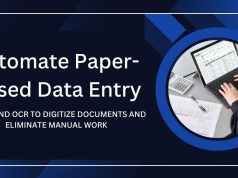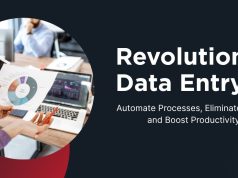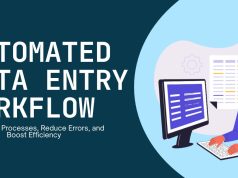The Increasing Demand of Automated Data Entry
Data is the lifeblood of today’s businesses. Whether it’s managing customer relationships or analyzing market conditions, companies rely on up-to-date, reliable data to drive smart decisions.
The Manual Entry of Data
The problem with manually entered data, however, is the time and the frustrations it can cause employees.
That’s where Automated Data Entry AI comes into play. Now, efforts can be automatically automated and made efficient with artificial intelligence – which means reduced human errors and more freed-up hours for employees to allocate to higher impact tasks. This article will cover what automated data entry is, its pros and cons, and how businesses can get it done right.
What is Automated Data Entry?
Automated data entry is when you use AI technology to handle the extraction, processing, and input of data into digital systems without user intervention. And, unlike conventional data-entry automations, which are rules-based, AI-enabled systems can be trained to identify patterns and handle complex unstructured data, for example handwritten notes or unformatted photographs.
Artificial Intelligence (AI) powered data entry tools leverage a combination of advanced technologies such as:
-
Optical Character Recognition (OCR): The process of translating an image of text, such as a scanned book page or license plate, into computer-readable text.
-
Natural Language Processing (NLP): This function allows a machine to read and interpret the human language, which is great if you need to extract information from your emails or contracts for example.
-
Machine Learning (ML): Systems use new data to learn from and improve accuracy over time.
Pairing these technologies together, AI for automated data entry is a smarter, faster way to solve your manual data management problems.
Advantages of AI-based Data Entry Automation
Here are the key benefits of automated data entry AI for companies in different sectors:
Enhanced Accuracy
As is so often the case with manual entry, human error is a significant problem, especially when faced with large amounts of data. AI-enabled systems can also more accurately process data, reducing errors that can have monumental impacts on a business.
Time and Cost Efficiency
The datentranscription tasks generally involve large amounts of time and costs. With the capacity to automate this service, businesses can save hours of time, as well as reduce the cost of maintaining data entry teams.
Scalability
Businesses always have varying work load for data entry. AI can process masses of data without breaking a sweat and scale up attendance when demand surges without their being forced to hire more staff.
Improved Compliance
A lot of the industries are also restricted with data protection and compliance regulations. Automation can make everything faster, less prone to errors, and can provide logs to ensure conformity with the law and industry regulation.
Employee Productivity
By automating the repeatable functions, organizations enable their staffs to concentrate on strategic, high-value activities such as customer experience, invention, or analysis. This enhances both job satisfaction and organizational efficiency.
Automated Data Entry: Examples and Use cases
Automated data entry AI is already really making a splash across so many industries. Here is only a sample of how it is changing businesses.
Healthcare
Health care professionals can use AI to derive patient information from handwritten records or lab reports, leading to more efficient processing and patient care.
Finance
Banks will also use AI to strip data out of forms such as loan applications or invoices. They make possible fast and accurate financial operations.
Retail and E-commerce
Automated systems assist retailers in processing online orders, tracking inventory and gathering customer feedback. AI can even comb through customer reviews for market analysis.
Logistics
For shipping companies, AI-based data systems streamline processes by handling shipping labels, invoices, and inventory lists more efficiently.
Human Resources
Hiring related tasks such as parsing resumes and entering candidate data are efficient today thanks to AI driven automated data entry products.
Challenges and Considerations
Automated data input AI is clearly front-loaded with some big pluses, but businesses should also take account of some potential challenges in deploying this technology.
Initial Investment
AI based systems must invest up-front in both software and hardware. Yet long-term benefits often outweigh these costs.
Data Security Risks
Sensitive information is processed by automated systems. There is heavy dependence on this data and need to secure it from hackers. Organizations will have to make sure their AI services are built on strict data security standards.
Unstructured Data Complexity
Great at structured…. not so much at unstructured data like terrible scribbled text or low-grade snapshots. Choosing a solution that has strong machine learning engines will avoid this problem.
Employee Readjustment
Automation of tasks could elicit pushback from workers worried about the future of their jobs. Transparent communication must be a priority for organizations and employees need to be reskilled to tackle higher-value jobs.
Automated Data Entry Using What to Use, Implementing, and called as
If companies are to harness the power of AI data entry automation, they need to take a structured approach to its implementation. Here’s how to get started.
Step 1. Evaluate Current Processes
Notice the places in your organization which are the most time-consuming or mistake-prone with manual data entry. It will be easier to decide on the right AI solution if you know what your pain points are.
Step 2. Choose the Right AI Platform
Assess tools using features like OCR, integration, and machine learning models. Solutions such as ABBYY, UiPath, or the Azure AI from Microsoft are used quite frequently at large enterprises to fulfill data entry requirements.
Step 3. Ensure Data Security
Choose solutions that put data protection and compliance first!
Step 4. Pilot Test the System
A small-scale evaluation is recommended to assess system accuracy and to identify potential enhancements, before conducting large-scale deployment.
Step 5. Train Your Team
Provide actual training to get your employees up to speed on the new system. Answer their questions about how it will affect their jobs.
Step 6. Monitor and Refine
Work on effectiveness of the system, error rates, feedback from workers. Leverage this data to test into higher ROI improvements.
Data Entry’s Future is AI
Fully automatic data entry is the future, which is powered by AI. Able to minimize errors, enhance productivity, and accommodate business requirements, automated data entry AI is more than an advantage—it’s a requirement—for forward-thinking companies.
It leads here nonetheless – and now is the time to build these tools into your business to keep it competitive in a data-centric future.
Explore the evolving landscape of marketing and why digital channels are becoming essential in our insightful piece on Why Digital Marketing is the Future.










